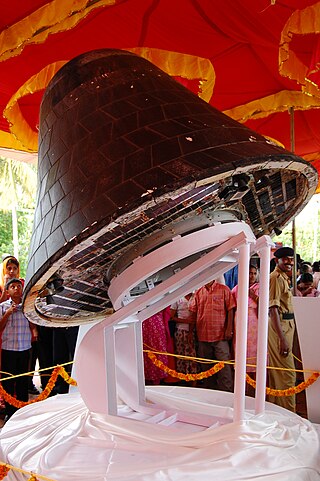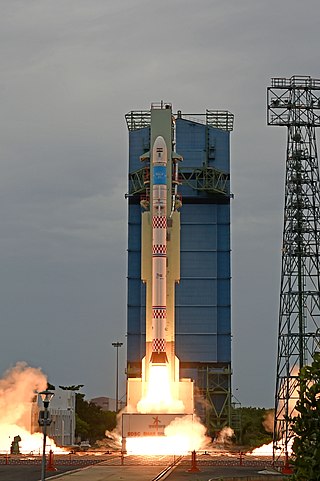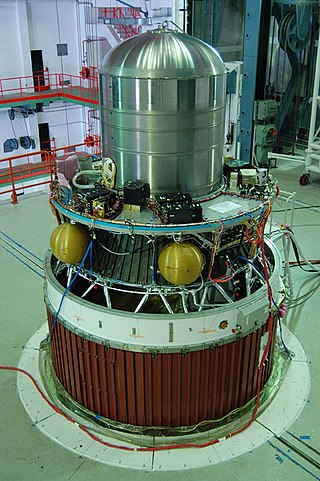
The Polar Satellite Launch Vehicle (PSLV) is an expendable medium-lift launch vehicle designed and operated by the Indian Space Research Organisation (ISRO). It was developed to allow India to launch its Indian Remote Sensing (IRS) satellites into Sun-synchronous orbits, a service that was, until the advent of the PSLV in 1993, only commercially available from Russia. PSLV can also launch small size satellites into Geostationary Transfer Orbit (GTO).

Anti-satellite weapons (ASAT) are space weapons designed to incapacitate or destroy satellites for strategic or tactical purposes. Although no ASAT system has yet been utilized in warfare, a few countries have successfully shot down their own satellites to demonstrate their ASAT capabilities in a show of force. ASATs have also been used to remove decommissioned satellites.

Space debris are defunct human-made objects in space – principally in Earth orbit – which no longer serve a useful function. These include derelict spacecraft – nonfunctional spacecraft and abandoned launch vehicle stages – mission-related debris, and particularly numerous in Earth orbit, fragmentation debris from the breakup of derelict rocket bodies and spacecraft. In addition to derelict human-made objects left in orbit, other examples of space debris include fragments from their disintegration, erosion and collisions or even paint flecks, solidified liquids expelled from spacecraft, and unburned particles from solid rocket motors. Space debris represents a risk to spacecraft.

The Indian Space Research Organisation is the national space agency of India. It operates as the primary research and development arm of the Department of Space (DoS), which is directly overseen by the Prime Minister of India while the Chairman of ISRO also acts as the executive of DoS. ISRO is primarily responsible for performing tasks related to space-based operations, space exploration, international space cooperation and the development of related technologies. ISRO is one of the six government space agencies in the world that possesses full launch capabilities, can deploy cryogenic engines, can launch extraterrestrial missions and operate a large fleet of artificial satellites. ISRO is one of the four government space agencies to have soft landing (uncrewed) capabilities.

The year 2007 contained several significant events in spaceflight, including a Chinese ASAT test, the launches of the US Phoenix and Dawn missions to study Mars and Asteroid belt respectively, Japan's Kaguya Lunar orbiter, and the first Chinese Lunar probe, Chang'e 1.
The Integrated Space Cell was the nodal agency within the Government of India with oversight of the security of its space based military and civilian hardware systems. It was to be jointly operated by all the three services of the Indian Armed Forces, the civilian Defence Research and Development Organisation and the Indian Space Research Organisation (ISRO). This agency was superseded by Defence Space Agency in 2019.[better source needed]
Strictly speaking, a satellite collision is when two satellites collide while in orbit around a third, much larger body, such as a planet or moon. This definition can be loosely extended to include collisions between sub-orbital or escape-velocity objects with an object in orbit. Prime examples are the anti-satellite weapon tests.

This article documents notable spaceflight events during the year 2019.
PSLV-C3 was the third operational launch and overall sixth mission of the PSLV program. This launch was also the forty-sixth launch by Indian Space Research Organisation since its first mission on 1 January 1962. The vehicle carried three satellites which were deployed in the Sun-synchronous Low Earth orbit. The vehicle carried Technology Experiment Satellite, BIRD and PROBA. This was India's and ISRO's second commercial spaceflight. PSLV-C3 was launched at 10:23 a.m. IST on 22 October 2001 from Satish Dhawan Space Centre.

Microsat-TD was an Earth observing satellite developed by ISRO. Its launch marked India's 100 satellites in space. This satellite could capture images at night by imaging in infrared spectrum.

The Small Satellite Launch Vehicle (SSLV) is a small-lift launch vehicle developed by ISRO with payload capacity to deliver 500 kg (1,100 lb) to low Earth orbit or 300 kg (660 lb) to Sun-synchronous orbit for launching small satellites, with the capability to support multiple orbital drop-offs. SSLV is made keeping low cost, low turnaround time in mind with launch-on-demand flexibility under minimal infrastructure requirements.

The PSLV-C44 was the 46th mission of the Indian Polar Satellite Launch Vehicle (PSLV) program. It was the first flight of PSLV-DL, having 2 strap-on boosters and placed a primary payload Microsat-R and a secondary payload of Kalamsat V2 in Sun-synchronous orbits.

The PSLV-C45 is the 47th mission of the Indian Polar Satellite Launch Vehicle (PSLV) program. The Polar Satellite Launch Vehicle (PSLV)-C45 was launched on 1 April 2019 with a payload of 29 satellites, including one for electronic intelligence, along with 28 customer satellites from other countries.

On 27 March 2019, India tested an anti-satellite weapon (ASAT) during an operation code named Mission Shakti. The target of the test was a satellite present in a low Earth orbit, which was hit with a kinetic kill vehicle.

Kosmos-1408 was an electronic signals intelligence (ELINT) satellite operated by the Soviet Union. It was launched into low Earth orbit on 16 September 1982 at 14:55 UTC, replacing Kosmos-1378. It operated for around two years before becoming inactive and left in orbit.

PSLV Orbital Experiment Platform (POEM) also known as PSLV Stage 4 Orbital Platform (PS4-OP) is an orbital micro-gravity test bed based on spent fourth stage of PSLV. By adding modular subsystems for power generation, communication and stabilization like photovoltaic cells, Telemetry and Telecommand (TT&C) package, attitude control system, data storage etc. to PSLV fourth stage it is converted into a satellite bus. This augmented stage can then host payloads for up to six months while in orbit, making it useful for qualifying components, gaining space heritage and conduct experiments in micro-gravity conditions. Usually the fourth stage of PSLV is discarded after deployment of satellite and remains in orbit for a significant duration in a passive state as a piece of space debris.














